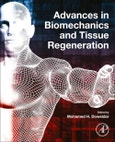Advances in Biomechanics and Tissue Regeneration covers a wide range of recent development and advances in the fields of biomechanics and tissue regeneration. It includes computational simulation, soft tissues, microfluidics, the cardiovascular system, experimental methods in biomechanics, mechanobiology and tissue regeneration. The state-of-the-art, theories and application are presented, making this book ideal for anyone who is deciding which direction to take their future research in this field. In addition, it is ideal for everyone who is exploring new fields or currently working on an interdisciplinary project in tissue biomechanics.
Please Note: This is an On Demand product, delivery may take up to 11 working days after payment has been received.
Table of Contents
Advances in Biomechanics and Tissue Regeneration
Part I: Biomechanics
1. Personalized corneal biomechanics
2. Biomechanics of the vestibular system: a numerical simulation
3. Design, Simulation and Experimentation of Colonic Stents
4. Mechanical and Micro-Structural Behavior of vascular tissue
5. Impact of Fluid-Structure Interaction Modelling on the human vessel hemodynamics
6. Review of the essential role of SMCs in regulating the stress distribution across the aortic wall
7. Multiscale numerical simulation of the lung and heart electrophysiology
8. Real-time modelling of the heart
9. COMPUTATIONAL MUSCULOSKELETAL BIOMECHANICS OF THE KNEE JOINT
10. Determination of the anisotropic mechanical properties of bone tissue using a homogenization technique combined with meshless methods
11. Analysis of the biomechanical behaviour of osteosynthesis based on intra-medullary nails in femur fractures
12. Stress Redistribution in the Calcaneus After Autologous Bone Harvest
Part II: Mechanobiology and tissue regeneration
13. Tissue regeneration through electrically and magnetically active microenvironments
14. USING 3D PRINTING AND BIOPRINTING TECHNOLOGIES FOR PERSONALIZED IMPLANTS
15. Computational Simulation of the Cell Behavior for Tissue Regeneration
16. On the simulation of organ on chip cell processes. Application to an in vitro model of glioblastome evolution
17. Skin mechanobiology and biomechanics: from homeostasis to wound healing
18. Cartilage Regeneration and Tissue Engineering
19. Impact of mechanobiological perturbation on cartilage tissue engineering
20. Biomechanical analysis of bone tissue after insertion of dental implants using meshless methods: stress analysis and osseointegration
21. Numerical assessment of bone tissue remodelling of a proximal femur after insertion of a femoral implant using an interpolating meshless method








